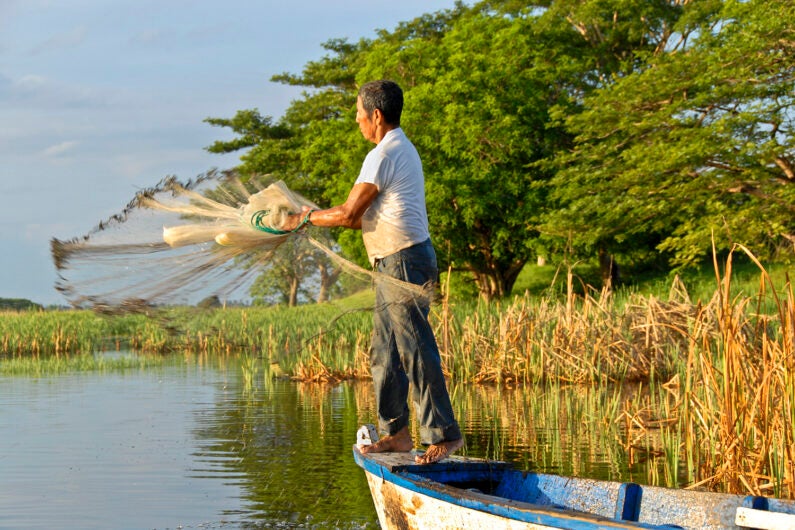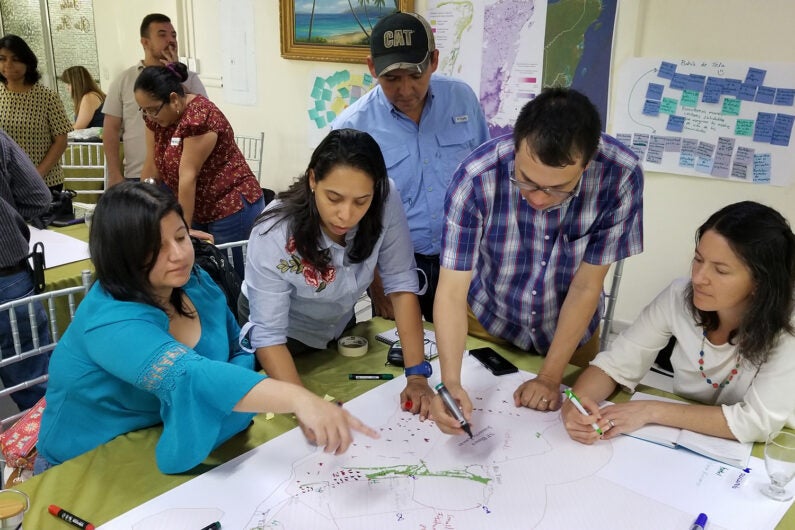Coral underwater close to Half Moon Caye island, a pure monument of Belize within the Lighthouse Reef Atoll. (Picture credit score: Antonio Busiello, WWF)
Governments within the Mesoamerican Reef area are exploring using nature-based options to strengthen coral well being and societal advantages for coastal communities. A brand new research in Nature Sustainability led by Stanford researchers in collaboration with scientists from the World Wildlife Fund, the Wholesome Reefs Initiative, and others from the Sensible Coasts mission quantified the outcomes of various watershed interventions to assist coral well being at regional versus nationwide scales, and recognized goal areas that would enhance each ecosystem and societal advantages nationally and throughout the area.
The character-based approaches evaluated as key watershed (e.g., drainage space) interventions embody ecosystem restoration or safety, and sustainable agriculture. But figuring out which areas to focus on for these interventions requires understanding the advanced relationships between terrestrial and marine ecosystems, also called “land-sea linkages,” their advantages to folks, and the spatial scale being thought-about.
This work pushed the boundaries of how scientists analyze biophysical and ecological relationships, utilizing cutting-edge optimization fashions (for the primary time in a coastal context) of easy methods to maximize advantages – and to whom – whereas assembly spatial or useful resource constraints.
“To revive nature – on this case, a big barrier reef – worldwide collaborative actions at a big scale are what’s going to actually assist,” stated Jade Delevaux, the research’s lead writer and senior fellow at Stanford’s Pure Capital Venture. “On the identical time, if you wish to assist coastal communities’ resilience by defending properties and infrastructure alongside the coast or tourism-based livelihoods – you’re in all probability making choices on a smaller scale.”
The analysis targeted on illuminating a few of these trade-offs for decision-makers and looking for locations the place there may be win-wins for the setting and folks.
Land-sea connections
Wholesome coral reefs present important financial, social, and environmental advantages to the communities that depend upon them. These embody coastal safety from storms, local weather regulation, nature-driven tourism, and fisheries that feed communities.
Whereas marine ecosystems could be affected by human actions within the ocean, like dredging or aquaculture, or pure hazards resembling hurricanes, they’re additionally affected by the well being of upstream terrestrial ecosystems. Intensified deforestation in mangroves and tropical forests is a key issue, because it worsens air pollution and carbon emissions on land. It additionally results in sediment runoff from lack of their root techniques, which harms downstream coastal water high quality and consequently coral reef well being.
The coastal and marine ecosystems of the Mesoamerican Reef stretch over 1,000 kilometers, establishing it as the biggest transboundary barrier reef system within the Northern Hemisphere. Belize, Guatemala, and Honduras, three nations within the area, considerably have an effect on the reef by way of human actions that influence the coastal watersheds. But these watersheds don’t at all times align with political boundaries, complicating coverage interventions.
“It could be laborious to justify, even scientifically, asking Guatemala or Honduras to finance watershed interventions if many of the advantages are accrued by the folks in Belize,” stated Delevaux. “That’s once we requested the query: in case you have been to handle watersheds with an eye fixed in the direction of supporting each folks and local weather resilience, would you goal the identical areas as you’d in case you have been solely targeted on coral reef well being?”

A fisherman casts his fishing internet to catch shrimps in a mangrove off the coast of Guatemala. (Picture credit score: MayaCom, iStock)
Mapping advantages throughout scales
To reply that query, researchers and native companions recognized goal areas the place three key watershed interventions may very well be applied: restoration of agricultural land to native forest; safety of present forest; and sustainable agriculture – changing typical agriculture and ranching to agroforestry and silvopasture.
“It was wonderful to see the extent of coordination and collaboration occurring whereas overlaying such a big geographic space. The communities’ data, wants, and questions actually influenced the science by way of the numerous workshops, participatory mapping workout routines, and capability trainings we held to assemble the knowledge for these analyses,” stated Delevaux. “I’d say that a part of the work was actually inspiring, since you see the way it’s going for use firsthand.”
Then, utilizing InVESTⓇ ecosystem companies fashions, Delevaux and colleagues quantified the consequences of various interventions in numerous goal areas on coral well being by way of sediment retention. They discovered that a very powerful goal areas for coastal communities – the place interventions would maximize societal advantages like tourism, fisheries, and coastal safety – modified relying on whether or not they prioritized a regional- versus national-scale scale strategy.
Sediment retention and coral well being enhance essentially the most in fashions prioritizing regional interventions that concentrate on bigger, transnational watersheds. A nationwide emphasis on smaller, non-transboundary watersheds lined by reefs gives extra localized societal advantages.
“On the regional scale, throughout nations, we discovered we’ve got the perfect alternatives for making investments in watersheds which can be going to assist scale back sedimentation and improve coral well being throughout the area,” stated Katie Arkema, senior fellow on the Pure Capital Venture and senior scientist on the Pacific Northwest Nationwide Lab, with a joint appointment on the Faculty of Marine Environmental Affairs on the College of Washington. “On the nationwide scale, we will make investments which can be going to essentially particularly profit the coastal communities in that nation by way of these societal ecosystem service advantages,” stated Arkema.
Whereas the research outcomes present trade-offs between regional coral well being and country-level societal advantages, there have been additionally some interventions that prioritized related goal areas in each.
“These spatially express outcomes are empowering for each native and regional managers. A donor or investor may be fascinated about enhancing reef well being in a particular reef space or Marine Protected Space and will use these outcomes to focus on the watersheds that yield most enchancment of their focal space. A nationwide authorities might decide the perfect set of interventions and watersheds that maximize each social and ecological advantages,” stated Melanie McField, co-author, founder, and director of the Wholesome Reefs for Wholesome Individuals Initiative.
“The mannequin may also quantify the regional reef and social profit to cooperative work within the main watersheds, supporting potential large-scale multi-national conservation efforts.”

Katie Arkema and attendees collaboratively add to maps in a 2015 Honduras workshop. (Picture credit score: Stacie Wolny)
Co-creating for the long run
Researchers co-designed the research with native companions, together with Wholesome Reefs for Wholesome Individuals, and regionally primarily based associates of the World Wildlife Fund.
In Honduras, the outcomes of the research are serving to to information investments in watershed restoration by way of replanting mangrove forests to reduce sediment runoff.
For Belizeans in Placencia, these outcomes add to virtually twenty years of assist for mangrove-forward improvement between the Pure Capital Venture, WWF, Belize Coastal Zone Administration Authority and Institute (CZMAI), and others. Delevaux additionally continues to work with communities in Placencia, Belize by way of an NSF mission to search out equitable nature-based options like mangrove restoration and conservation on the native stage.
“It may be helpful to emphasise for decision-makers that we do have some quantitative fashions and instruments that may assist assist the sorts of selections they need to make on the place to direct funds. [Our research] might help present insights into how the selections that they make at the moment would possibly affect what occurs sooner or later,” stated Arkema.
Extra Stanford co-authors embody ecosystem companies analyst Jess Silver and senior GIS analyst Stacie Wolny, each affiliated with the Pure Capital Venture. Extra co-authors are from Seascape Options LLC; the College of Washington; World Wildlife Fund-Mesoamerica; World Wildlife Fund, Mexico; World Wildlife Fund, Washington, D.C., USA; Sound GIS; Wholesome Reefs for Wholesome Individuals; and Pacific Northwest Nationwide Laboratory.
This research was funded by the Worldwide Local weather Initiative (IKI) Sensible Coasts; the Gordon and Betty Moore Basis; the Nationwide Science Basis Shoreline and Individuals prime settlement; the Marianne and Marcus Wallenberg Basis, the Summit Basis, and CORESCCAM BNP-PARIBAS basis.






























































